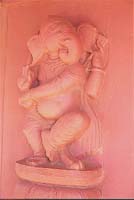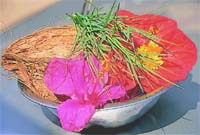


|
|
|
GANPATIPULE is one of the most spectacular beaches along the Konkan coast, a half-hour�s journey from Ratnagiri along a smooth and winding road, and if you are driving to Bombay then take the 43-km detour off the highway and go visit the little seaside township. It is famous for just one reason: the Swayambhu Ganpati Temple on the beach. Swayambhu means self-originated. And legend has it that the affable Lord Ganesh, lotus in one hand and astride his trusty mouse, descended on this beach with his army of soldiers (gana) and lent his name to the sand dunes (pule) some 400 years ago. Since then, Ganapatipule has been the ideal getaway for peace-seekers, beach-lovers and Ganesh worshippers.
The temple stands on the beach itself. And the beach offers clear waters and clean sand, it is also rich in flora, there are mangroves and coconut palms for miles around. It is also sparsely populated. Guide books say, on weekend the tourists outnumber the locals on the Ganapatipule beach! Outside the temple, small shacks sell items for the puja that is performed outside, and there are rows of tender coconut stalls. Mango season, the Alphonso mango is king here. It is available everywhere, cheaply, golden yellow and sun-kissed. No tourits to the Swayambhu Ganpati Temple goes back without a basket of the fruit. The temple itself faces the sea, with gardens and a large fibre glass mouse (Ganpati�s vahan, or vehicle), and the Ganpati idol bursting from a rock. Each year, between February 2 and 8, and November 2 and 8, the evening sun�s rays fall directly on the idol in the temple. Thousands of the faithful come to Ganapatipule at these times of the year to witness the miracle of the sun-worshipping Ganpati. Evenings, when the last naivedyam is offered to the idol, the priests chant the mantra-pushpa and let Ganpati rest for the night. Then they distribute prasad to the devotees. And at nightfall, the beach is taken over by the picnic crowd.
Several small eaterieoutside MTDC, like Kelkars, offer visitors a sample of genuine Konkani vegetarian food. The cuisine is flavoursome and smacks of coconut, coriander, lime and the spice blend simply known as Goda Masala. On the beach, a number of shacks sell bhajiyas and polis. Throughout the year, at the main market, Konkani ingredients like Kokum Sherbet, Besan Ladoo, and papads made of mango and jackfruit are available. The Modak too is very popular in Ganapatipule. It is offered an naivedyam to the idol. |

Home Page
About the mag
Subscribe
Advertise
Contact Us
 Lord Ganesh�s Seaside Residence
Lord Ganesh�s Seaside Residence
 The God in this Swayambhu Ganpati Temple is considered to be the Paschim Dwardevta or God of the west coast. Ganpati is very popular with people of the Konkan region and the crowds of worshippers who come to the temple on Angar ki Chaturvehi, an auspicious Tuesday every six months, has to be seen to be believed. Ganesh Chaturthi is another occasion for the faithful to congregate on the Ganapatipule beach in their thousands. The festival also draws foreign tourists to the temple, they come to discover the landscape, art, culture and history of
the region.
The God in this Swayambhu Ganpati Temple is considered to be the Paschim Dwardevta or God of the west coast. Ganpati is very popular with people of the Konkan region and the crowds of worshippers who come to the temple on Angar ki Chaturvehi, an auspicious Tuesday every six months, has to be seen to be believed. Ganesh Chaturthi is another occasion for the faithful to congregate on the Ganapatipule beach in their thousands. The festival also draws foreign tourists to the temple, they come to discover the landscape, art, culture and history of
the region.
 There are plenty of hotels to stay in at this seaside town, and among them, the most popular is the MTDC Holiday Resort. It has 41 self-contained blocks, 19 group accommodation blocks, ten deluxe AC non-AC blocks and 35 seasonal tents. Reservations can be made at Bombay, Ratnagiri, Goa, Pune, Kolhapur, Ganapatipule and any MTDC office. It is the hotel closest to the beach and temple and has plenty of parking facilities, water sports, offers a superb view of the sea because it is situated on a hillock, has a decent restaurant and bar, and is by far the most happening place in Ganapatipule.
There are plenty of hotels to stay in at this seaside town, and among them, the most popular is the MTDC Holiday Resort. It has 41 self-contained blocks, 19 group accommodation blocks, ten deluxe AC non-AC blocks and 35 seasonal tents. Reservations can be made at Bombay, Ratnagiri, Goa, Pune, Kolhapur, Ganapatipule and any MTDC office. It is the hotel closest to the beach and temple and has plenty of parking facilities, water sports, offers a superb view of the sea because it is situated on a hillock, has a decent restaurant and bar, and is by far the most happening place in Ganapatipule.